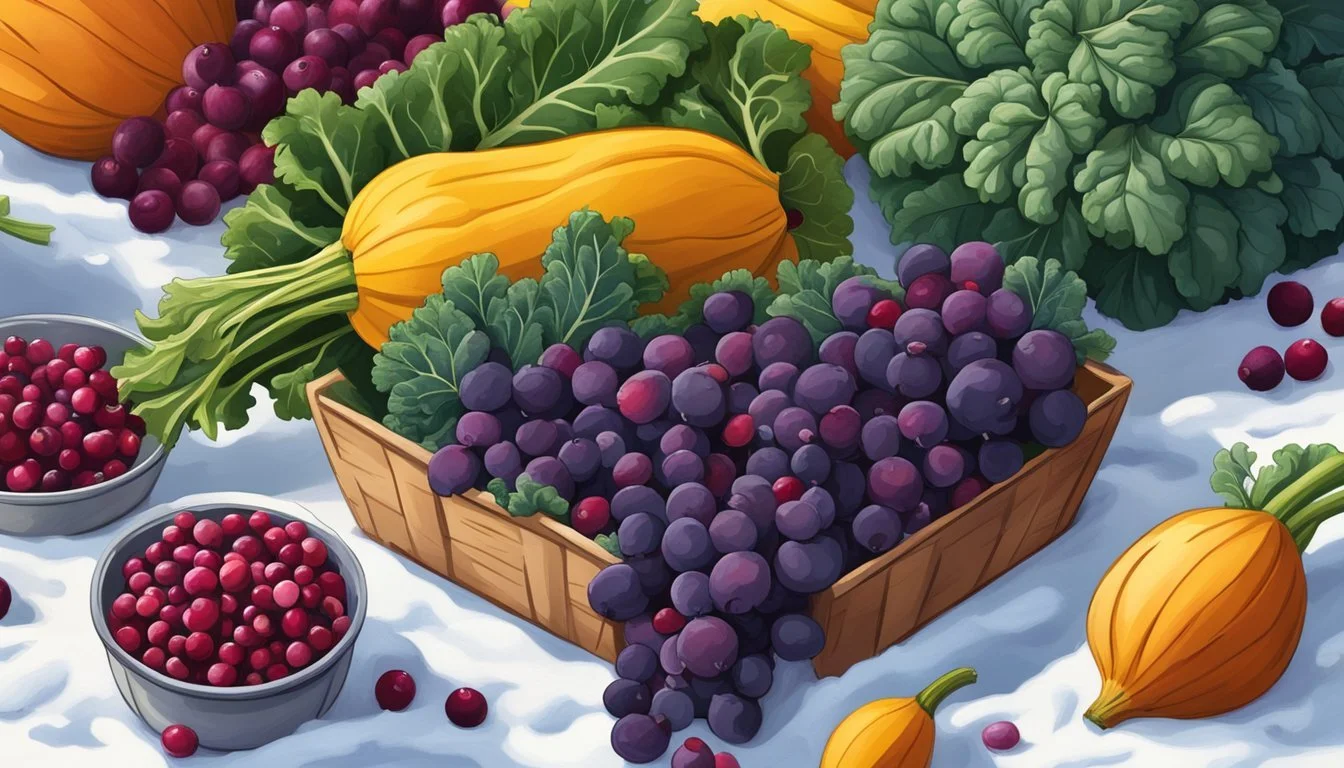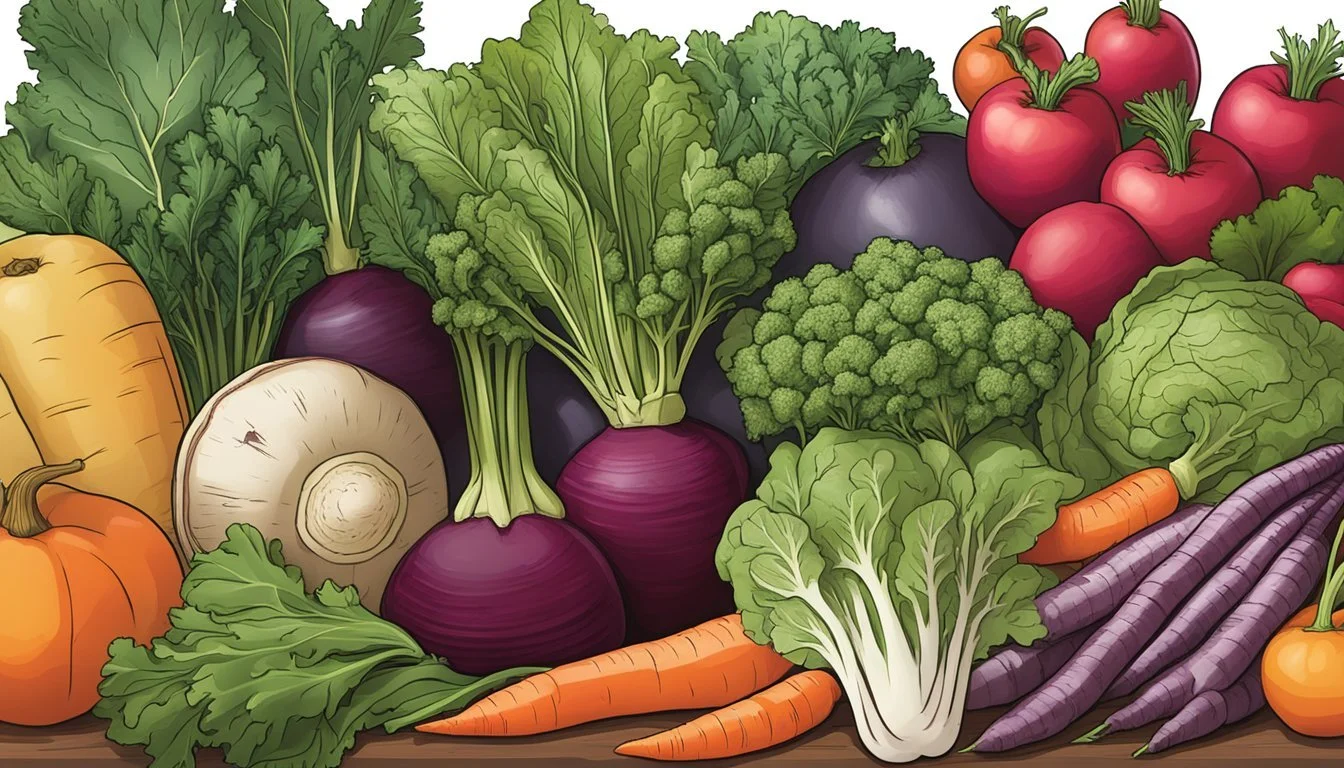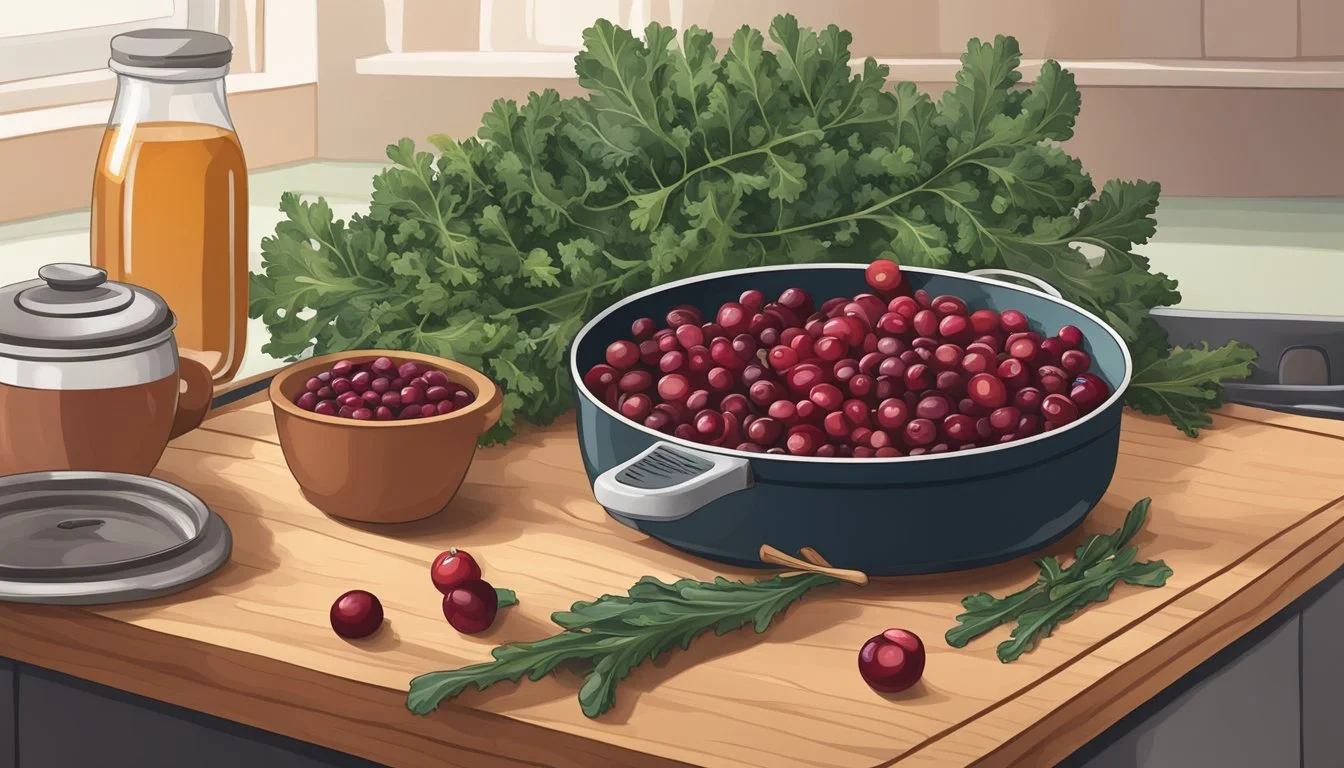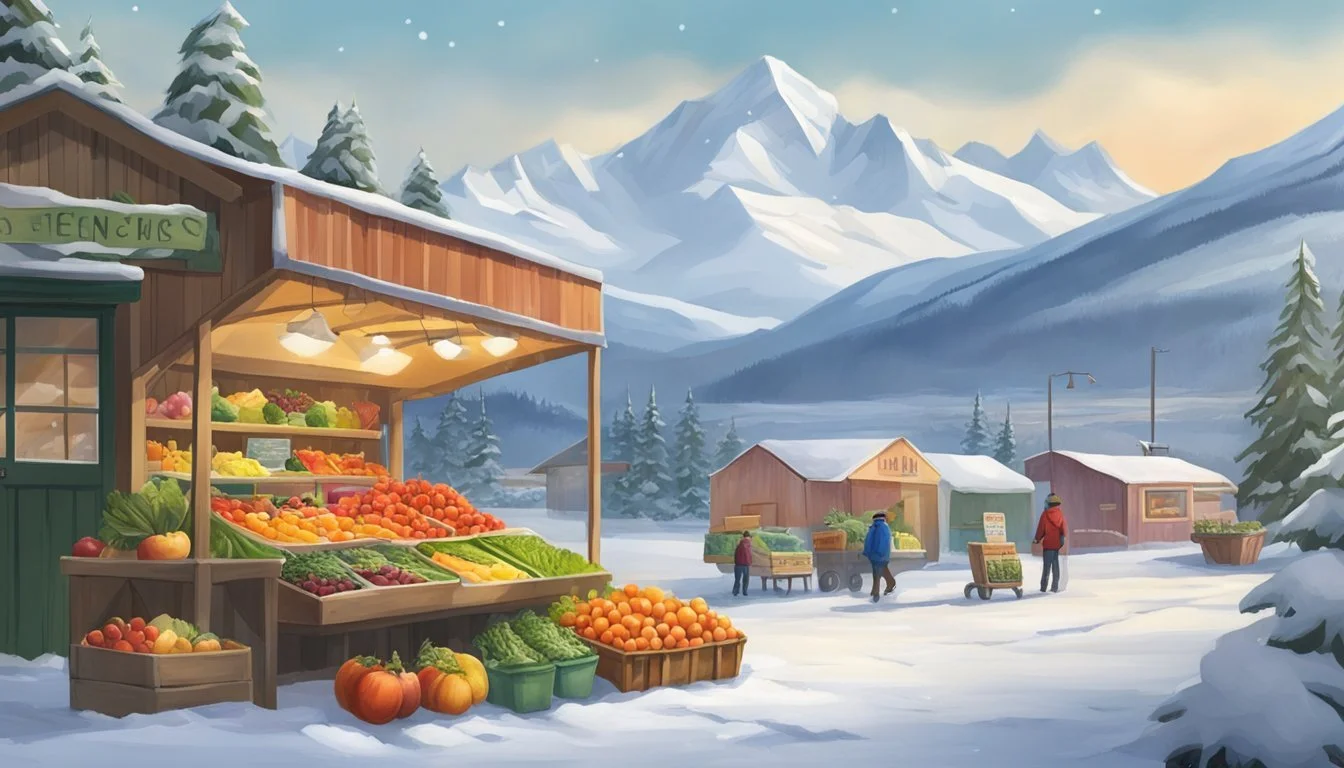Alaska Seasonal Fruit & Vegetables in December
A Guide to Winter Produce
This Article is Part of our Alaska Seasonal Fruit & Veg Calendar
In the depths of winter, Alaska offers a selection of seasonal fruits and vegetables that flourish despite its rigorous climate. December’s prolonged nights and frigid temperatures shape a unique harvesting calendar for those seeking locally grown, fresh produce. Residents and enthusiasts of Alaskan agriculture turn to the bounty of hardy root vegetables and greenhouse-grown crops that are available during this time.
The local appetite for seasonal eating brings to light the root vegetables such as carrots and potatoes that are stored from earlier harvests to be enjoyed throughout the colder months. While the options for fresh fruits are limited, greenhouse cultivation and cold storage extend the availability of certain produce items. Alaskans make clever use of these methods to enhance the longevity and availability of their crops.
Thus, the selection of fruits and vegetables in December in Alaska, although curated by the environment's natural restrictions, continues to support a culture of fresh, seasonal consumption. This reliance on local harvests not only aligns with sustainable practices but also promotes a deeper appreciation for the robust flavors and nutritional benefits of produce that withstands the Alaskan winter.
Understanding Alaska's Winter Season
Alaska's winter season spans from late October through March, with December often epitomizing the cold and snowy climate pervasive during this time. The state experiences significantly shorter days and longer nights, with temperatures routinely dropping below freezing. It is essential for Alaskans and visitors alike to reference a guide when considering local produce, as the in-season selection is markedly different from that of warmer months.
December in Alaska is characterized by a unique combination of challenges and adaptations in agriculture due to the severe winter conditions. Residents and farmers utilize methods like hoop houses to extend the growing season of certain crops. Despite the cold climate, some hardy vegetables remain in season, thriving in the frigid temperatures.
The typical in-season produce during December includes:
Root Vegetables: carrots, potatoes, beets
Cabbage
Kale
Late harvest crops that store well into winter: onions, winter squash
The state's winter season limits the variety of fresh fruits and vegetables available. Nevertheless, Alaska's guide to winter produce accounts for storage techniques that keep the last of fall's harvest edible throughout the colder months. It's a testament to the resilience of both the people and the produce that can weather the state's demanding climate.
Seasonal Fruit Highlights
December in Alaska offers a selection of fruits that are vibrant, packed with nutrients, and ideal for a variety of culinary uses. They can be savored fresh, incorporated into smoothies, or added to salads (What wine goes well with salads?) .
Citrus Fruits
In December, citrus fruits are at their peak, offering freshness and a burst of sweetness to the Alaskan palette. The variety often includes:
Oranges: Oranges are a powerhouse of vitamin C and are versatile for eating raw or juicing.
Grapefruits: Known for their slightly tart flavor, grapefruits are a refreshing choice for breakfast or salads.
Lemons: Essential for cooking and baking, lemons add a zesty twist to both sweet and savory dishes.
Clementines and Mandarin Oranges: These sweeter, smaller citrus options are perfect snacks and excel in salads due to their seedless nature.
Pome Fruits
Pome fruits, such as apples and pears, remain a staple in December with their sweet taste and high fiber content. These fruits are:
Apples: With varieties that maintain their crispness well into winter, apples are excellent for eating raw or using in pies and ciders.
Pears: Soft, sweet, and juicy, pears complement both sweet and savory dishes and are delightful when enjoyed fresh.
Other Seasonal Offerings
Apart from the mainstream citrus and pome fruits, December also boasts other fruits that are cherished for their unique flavors and benefits:
Cranberries: Typically associated with festive dishes, these tart berries are also nutrient-rich and provide bold flavor to compotes and baked goods.
Kiwi: This exotic fruit adds a tropical flare and is sweet and tangy, making it a delightful addition to winter fruit salads.
Pomegranates: Known for their jewel-like seeds, pomegranates are packed with antioxidants and add a pop of sweet and sour taste to various recipes.
Seasonal Vegetable Selection
In the depths of December, Alaska's vegetable offerings are naturally heartier. These selections are superb for a range of dishes, from comforting soups to nutritious roasted side dishes.
Root Vegetables
In Alaska, root vegetables like carrots, parsnips, turnips, and rutabagas withstand the cold well and are often available fresh. Here's a glimpse at these versatile vegetables:
Carrots: Ideal for boiling or roasting, adding a sweet, earthy flavor to dishes.
Parsnips: Similar to carrots with a sweeter taste; perfect in soups or as a roasted side.
Turnips: With a slightly peppery taste, they can be roasted or boiled.
Beets: They bring vibrant color and sweetness to the table, whether roasted or boiled.
Other Notable Root Vegetables: Garlic, celery root (celeriac), and onions also play key roles in winter cooking.
Cruciferous Vegetables
Cruciferous vegetables like broccoli, brussels sprouts (how long do brussels sprouts last?), cabbage, kale, and cauliflower are members of the brassica family and offer robust flavors:
Broccoli: Best served cooked, either steamed or roasted.
Brussels Sprouts: Great for roasting to bring out a nutty flavor.
Cabbage: Versatile; used in salads, soups, or as a side dish.
Kale: A hearty green for salads or cooked dishes.
Cauliflower: Can be eaten raw, roasted, or used in soups.
Winter Squashes
Winter squashes such as butternut squash (how long does butternut squash last?), acorn squash, and others are staples:
Butternut Squash: With a sweet, nutty taste, it's perfect in soups or as a roasted side.
Acorn Squash: Ideal for baking or stuffing, with a mild, buttery flavor.
Winter squashes like squash and sweet potatoes are not only flavorful but also highly nutritious, providing a comforting, sweet taste amidst the cold months.
Leafy Greens & More
Even in the cold, some leafy greens remain available and are a refreshing addition to the Alaskan winter diet:
Spinach: It can be used in both raw salads and as a cooked side.
Lettuce: While not as robust in winter, hardy varieties may still be found for fresh salads.
Vegetables like greens remain key components for a balanced diet during the winter and can be used creatively across various dishes.
Suggested Cooking Methods & Dishes
Alaska's seasonal produce in December can be transformed into warming dishes that are perfect for the cold weather. Cooking methods like roasting and boiling bring out the natural sweetness and earthy flavors of root vegetables and hearty greens, while the use of fats such as olive oil can add a layer of richness.
Root Vegetables: They are versatile and can be prepared in numerous ways. They can be roasted with a drizzle of olive oil and a sprinkle of salt to create a simple, yet delicious side dish. Incorporating them into soups and casseroles adds depth and heartiness.
Roasted: Toss rutabagas or turnips in olive oil and roast until tender.
Soup: Boil root vegetables to make a creamy soup with added herbs for flavor.
Casseroles: Layer sliced roots with cheese for a gratin-style casserole.
Leafy Greens: Chard and kale remain sturdy and are suitable for both raw and cooked applications. They can be sautéed with garlic for a quick side or added to pastas for a nutritional boost.
Salads: Use kale or chard raw in salads, dressed with a mild vinaigrette.
Sautéed: Cook these greens with olive oil and garlic as an accompaniment to proteins.
Pasta: Ribbon greens into pasta dishes for color and texture.
Brassicas: Brussels sprouts and cabbages take on a sweet, nutty flavor when grilled or roasted. These methods caramelize their natural sugars, enhancing the overall taste.
Grilled: Char Brussels sprouts on the grill for a smoky addition to salads.
Roasted: Quarter cabbages and roast with a brush of olive oil until the edges are crispy.
Sauce: Blend boiled brassicas into a sauce for a twist on traditional greens.
Utilize these suggestions to make the most of Alaska's seasonal offerings, creating dishes that are full of flavor and comforting during the chill of December.
Eating Seasonally for Health and Pleasure
In December, Alaskans have the unique opportunity to embrace the seasonal bounty of local produce that is not only nutritious but also offers a delightful sensory experience. One's diet can be greatly enriched by the inclusion of fresh and seasonal produce, which, although the choices may be more limited compared to the summer months, are still packed with nutrients and rich in fiber.
Root Vegetables: They stand out in the winter months, with options like carrots and beets that provide a sweet flavor and vibrant color to any dish.
Cabbage: This leafy green is a versatile and fiber-rich addition to both salads and warm meals.
Potatoes: A hearty staple that can be prepared in various ways to complement any meal with its comforting presence.
One can experience health benefits from eating seasonal fruits and vegetables, such as an enhanced immune system and a boost in fiber intake, critical during the colder and darker winter months. Alaskan produce, although limited during these times, retains a freshness that supermarket alternatives may lack.
By choosing local, individuals not only enjoy meals that are more connected to the environment around them but also support the local economy. The act of eating seasonally reinforces a cycle of health and pleasure, deeply rooted in the natural rhythm of one's locale, and provides an authentic taste of Alaska's seasonal offerings.
Here are a few recommended options for December:
Seasonal Produce Health Benefits Cabbage High in vitamins C and K, improves digestion Carrots Rich in beta-carotene, supports eye health Potatoes Good source of potassium, supports heart health
A December plate in Alaska is both a healthful and enjoyable endeavor, featuring nutrient-packed vegetables that cater to both the body's needs and the palate's desires.
Planning for Holiday Season and Gatherings
As the holiday season in Alaska approaches, individuals find themselves gearing up for festive gatherings with friends and family. Amidst the excitement lies an opportunity to showcase Alaska's seasonal produce. December may present challenges with its shorter days and colder temperatures, but the available fruits and vegetables during this time can still inspire a heartwarming feast.
Key Seasonal Produce to Consider:
Root Vegetables: Potatoes, turnips, and beets can be roasted or mashed for comforting side dishes.
Brassicas: Cabbages and Brussels sprouts offer a hearty accompaniment to main courses.
Winter Greens: Kale and Swiss chard can be incorporated into salads or sautéed as a warm side.
Recipe Ideas for the Holiday Table:
One can craft a menu that highlights the robust flavors and textures of these ingredients. Here, they present a guide to encourage culinary creativity:
Roasted Root Medley: A blend of golden beets, carrots, and parsnips, lightly seasoned and roasted until caramelized.
Brussels Sprouts with Cranberries: Halved Brussels sprouts sautéed with tart cranberries, adding a pop of festive color.
Creamy Kale Salad: Tender kale leaves massaged with a creamy dressing, topped with slivers of almonds and apple slices for crunch.
Preparing a holiday menu with local Alaskan produce not only supports local agriculture but also ensures that the holiday spread is infused with the freshest flavors. Those looking to imbue their holiday gatherings with Alaskan spirit will find these December offerings lend themselves to a variety of dishes that will delight and nourish.
Where to Find Fresh Seasonal Produce
In the cold month of December, Alaskans looking for fresh, seasonal fruits and vegetables have various options. They key is to focus on local sources that store or offer produce capable of enduring the harsh winter climate.
Local Farmers' Markets: Throughout Alaska, one may find community markets that offer cold storage produce harvested during its peak season. These markets typically provide items such as cabbage and carrots, which are available due to preservation techniques.
Community Supported Agriculture (CSA):
Arctic Harvest and other CSAs offer winter subscriptions, partnering with regional farms to deliver seasonal selections.
CSA Name Produce Highlights Subscription Arctic Harvest Winter shares of stored veggies, local meat and eggs Varies by plan
Grocery Stores: Local grocery stores often stock fruits and vegetables sourced from in-state farms, which have been placed in cold storage, ensuring freshness for longer periods. Cruciferous vegetables, root vegetables, and hardy greens commonly fall into this category.
Specialty Food Stores: These establishments may import certain items like cranberries or fennel (how long does fennel last?) that are harvested in the fall and remain fresh into winter. These products are native to North America and retain quality through the season.
Patrons seeking the freshest seasonal produce should inquire about the origins of the fruits and vegetables to ensure they are purchasing local, seasonal items. By doing so, they contribute to the local economy and enjoy produce that potentially has greater nutritional value due to reduced transport time.







